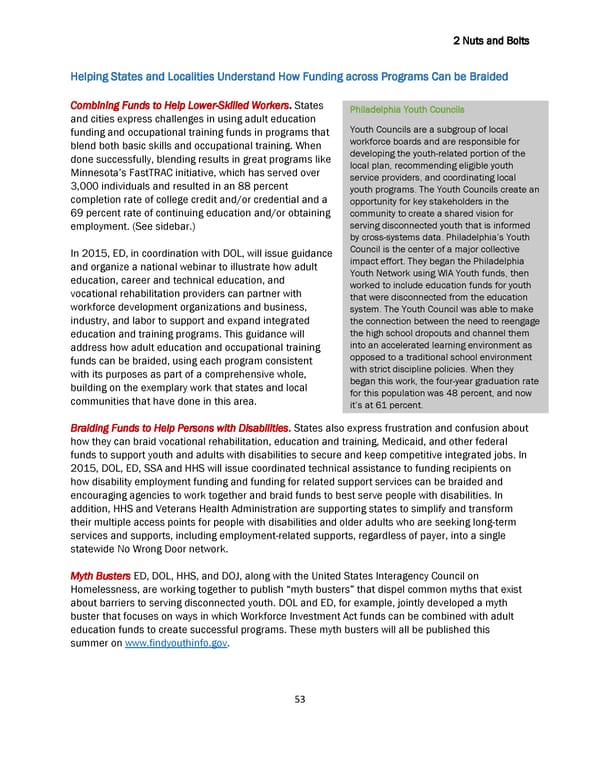2 Nuts and Bolts Helping States and Localities Understand How Funding across Programs Can be Braided Combining Funds to Help Lower-Skilled Workers. States Philadelphia Youth Councils and cities express challenges in using adult education funding and occupational training funds in programs that Youth Councils are a subgroup of local blend both basic skills and occupational training. When workforce boards and are responsible for done successfully, blending results in great programs like developing the youth-related portion of the Minnesota’s FastTRAC initiative, which has served over local plan, recommending eligible youth 3,000 individuals and resulted in an 88 percent service providers, and coordinating local youth programs. The Youth Councils create an completion rate of college credit and/or credential and a opportunity for key stakeholders in the 69 percent rate of continuing education and/or obtaining community to create a shared vision for employment. (See sidebar.) serving disconnected youth that is informed by cross-systems data. Philadelphia’s Youth In 2015, ED, in coordination with DOL, will issue guidance Council is the center of a major collective and organize a national webinar to illustrate how adult impact effort. They began the Philadelphia education, career and technical education, and Youth Network using WIA Youth funds, then vocational rehabilitation providers can partner with worked to include education funds for youth workforce development organizations and business, that were disconnected from the education system. The Youth Council was able to make industry, and labor to support and expand integrated the connection between the need to reengage education and training programs. This guidance will the high school dropouts and channel them address how adult education and occupational training into an accelerated learning environment as funds can be braided, using each program consistent opposed to a traditional school environment with its purposes as part of a comprehensive whole, with strict discipline policies. When they building on the exemplary work that states and local began this work, the four-year graduation rate communities that have done in this area. for this population was 48 percent, and now it’s at 61 percent. Braiding Funds to Help Persons with Disabilities. States also express frustration and confusion about how they can braid vocational rehabilitation, education and training, Medicaid, and other federal funds to support youth and adults with disabilities to secure and keep competitive integrated jobs. In 2015, DOL, ED, SSA and HHS will issue coordinated technical assistance to funding recipients on how disability employment funding and funding for related support services can be braided and encouraging agencies to work together and braid funds to best serve people with disabilities. In addition, HHS and Veterans Health Administration are supporting states to simplify and transform their multiple access points for people with disabilities and older adults who are seeking long-term services and supports, including employment-related supports, regardless of payer, into a single statewide No Wrong Door network. Myth Busters ED, DOL, HHS, and DOJ, along with the United States Interagency Council on Homelessness, are working together to publish “myth busters” that dispel common myths that exist about barriers to serving disconnected youth. DOL and ED, for example, jointly developed a myth buster that focuses on ways in which Workforce Investment Act funds can be combined with adult education funds to create successful programs. These myth busters will all be published this summer on www.findyouthinfo.gov. 53
 Biden Ready to Work White Paper 7/22/14 Page 52 Page 54
Biden Ready to Work White Paper 7/22/14 Page 52 Page 54